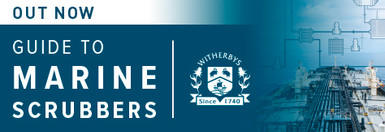Posted by Witherbys on 7th Jun 2023
Global marine scrubber market continues to rise
As stated in a recent BIMCO report: “the share of ships with a scrubber is set to increase in coming years as 17% of ships in the shipyards’ order books are expected to have a scrubber installed.” [‘Share of Ships with Scrubbers seen Rising Despite 24% Fall in Fittings in 2022’]
Scrubbers, often referred to as exhaust gas cleaning systems (EGCSs), are increasingly being used to comply with stricter regulations for sulphur oxide (SOx) emissions. The SOx emissions are produced from the combustion of fossil fuels that naturally contain sulphur compounds. The regulations to reduce harmful emissions of SOx (and associated particulate mater (PM)) from ships are:
• International, agreed by the International Maritime Organization (IMO), with a global fuel sulphur limit of 0.50% m/m since 2020
• regional, agreed by the IMO, with designated emission control areas (SOx-ECAs), such as the North Sea, the Baltic Sea and North America, enforcing a SOx-ECA fuel sulphur limit of ≤0.10% m/m since 2015, and
• domestic, for example in specified areas of China’s territorial waters, where SOx limits are now equivalent to an IMO ECA (0.10% m/m) for international ships in the Pearl River Delta, Yangtze River Delta, Bohai Rim Waters and Hainan waters.
The market for marine scrubbers has witnessed a steady growth due to the increasingly stringent SOx emissions requirements. In a report issued by Acumen Research and Consulting in August 2022, ‘Marine Scrubber Market Size – Global Industry Share, Analysis, Trends and Forecast 2022 – 2030’, the global scrubber market is es?mated to grow at a compound annual growth rate (CAGR) of 18.8% from 2022 to 2030. Driven in part by growing regulatory standards to reduce sulphur emissions, the market is es?mated to achieve a size of US$16.38 billion by 2030. The report also highlighted that hybrid scrubber technology, as opposed to open loop or closed loop scrubber systems, is expected to lead the market throughout the forecast period. This is due to the flexibility of operation offered by hybrid systems.
In order to comply with sulphur emission limits, ships must either use:
• Low or ultra-low sulphur marine gas oil (MGO), or
• heavy fuel oil (HFO), which is less expensive but contains sulphur compounds, and an onboard scrubber to reduce the sulphur emissions in the exhaust to a level equivalent to using low sulphur fuel.
The fluctuation in the cost of MGP versus HFO is a key factor. If there is a large difference, the payback time for the purchase and installation of a scrubber, as either a retrofit or a new build, can be relatively short. There are two key factors that influence the choice between using a scrubber and using low sulphur fuel:
• The projected price difference between MGO and HFO
• the power (MW) and fuel consumption of the ship.
“Reports throughout 2022 showed that ships fitted with scrubbers in many cases earned twice as much as those without” [‘The next scrubber retrofit wave will bridge the regulation gap’, Ship Technology, 2023]
A threat to the long-term prospects of the scrubber market is a further closing of the price gap between low sulphur and high sulphur fuels. Also, scrubber use may decline if low sulphur alternative fuels, such as ammonia or LNG, become more prevalent as a result of international decarbonisation initiatives. However, it should be noted that the retrofitting of some older ships to burn future fuels may not be possible. The availability of the future fuels may also be problematic on some routes. On the road to decarbonisation, it is crucial that these issues are handled correctly. A proven technology, such as a scrubber, should be considered so that older ships can continue to play a part in this significant environmental shift rather than be replaced.
While scrubbers can provide owners with an immediate SOx and PM emission reduction, alongside a high return on investment in the short term, investing in scrubber technology could also be a futureproofing solution in the midst of tightening decarbonisation goals. Research and development of innovative scrubber systems that include collecting CO2 emissions, alongside the conventional reduction of sulphur, is underway. This research could produce technology capable of an immediate carbon emission reduction, removing the need to wait for the development and rationalisation of alternative green fuel infrastructure and bridging the gap between existing and future environmental legislation.
For further information, please refer to ‘Guide to Marine Scrubbers’ published by Witherbys. This Guide contains comprehensive information on marine scrubbers that will assist ship owners and operators in complying with the 2020 global sulphur in marine fuel regulations.
Out now: ‘Guide to Marine Scrubbers’ https://shop.witherbys.com/guide-to-marine-scrubbers/

